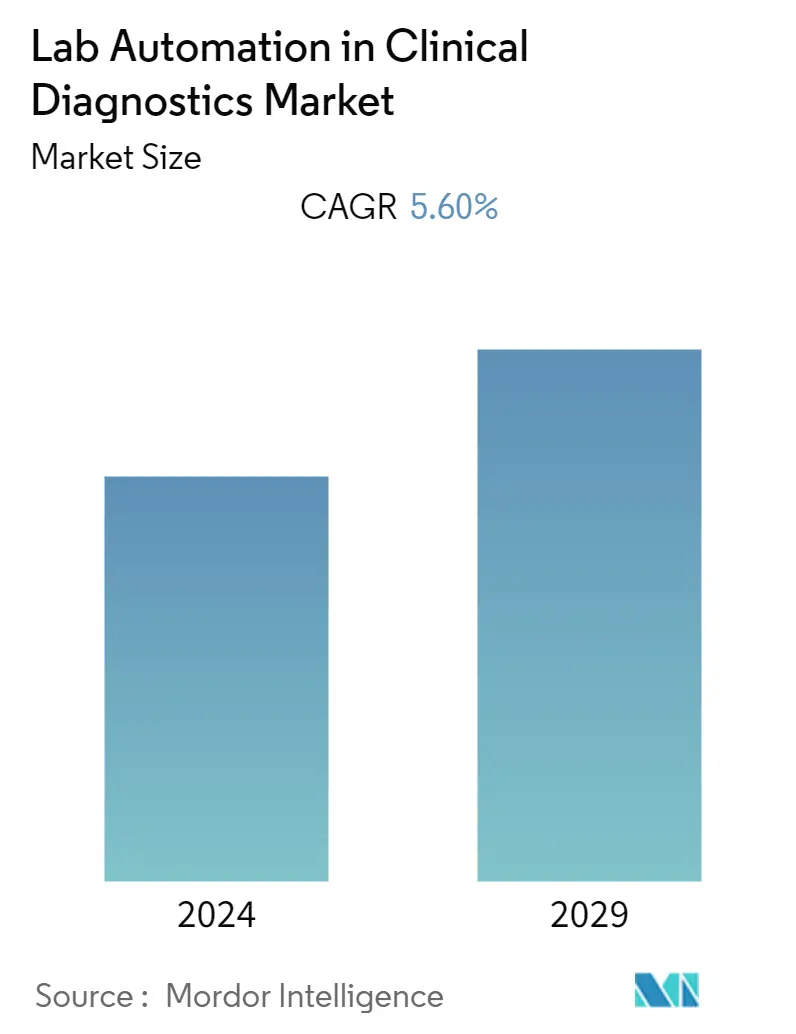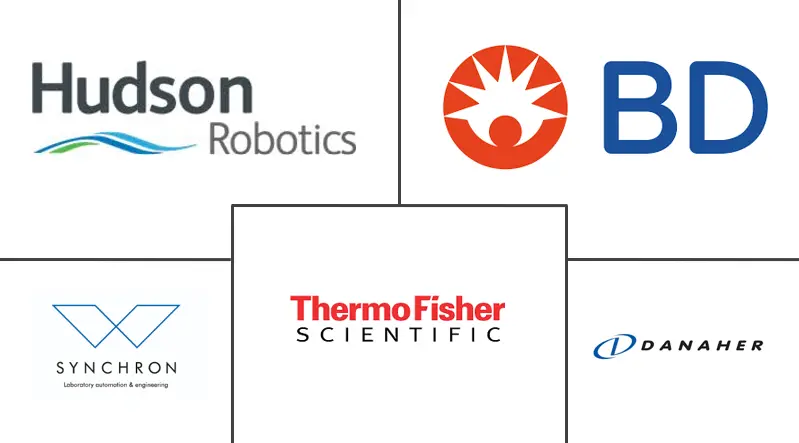Market Size of Lab Automation in Clinical Diagnostics Industry

| Study Period | 2019 - 2029 |
| Base Year For Estimation | 2023 |
| CAGR | 5.60 % |
| Fastest Growing Market | Asia-Pacific |
| Largest Market | North America |
| Market Concentration | Low |
Major Players
*Disclaimer: Major Players sorted in no particular order |
Lab Automation in Clinical Diagnostics Market Analysis
Lab Automation in the Clinical Diagnostics market is expected to register a CAGR of 5.6% during the forecast period (2021 - 2026). With the recent outbreak of the COVID-19 pandemic, there has been increased pressure on the laboratories to increase testing labs' capacity and speed. With the increase in the number of samples being tested every day, the market studied has been witnessing a growth in the developments of automation systems by vendors, which is expected to create opportunities for the studied market's growth.
- Across various industries, laboratories are a vital part of manufacturing and scientific research organizations. The primary goal of research and diagnostic labs is to provide high-quality and reliable information, which fulfills the industry's needs. The use of manual systems hampers data quality during the transferring process. The number of medical technicians, the drive to reduce costs, and an increasing need for diagnostic procedures for aging baby boomers, and new testing requirements collectively force the hospital and clinical laboratories to adopt automation equipment.
- Moreover, the rapid spread of existing diseases and discoveries increases the demand for early remedies and diagnoses. This is expected to ascend the rate of clinical diagnostic application, thereby fuelling the incorporation of lab automation equipment and software.
- Major vendors are launching new products to enlarge their product portfolio, which is expected to aid the market's growth over the forecast period. For instance, Beckman Coulter, a prominent vendor in clinical diagnostics, announced that the latest addition to its automation portfolio, the DxA 5000 total laboratory automation solution achieved European CE Mark and China Food and Drug Administration (FDA) approval.
- Laboratories are highly focused on improving patient care by driving faster turnaround time, offering quality results, and enhancing laboratory operations in today's healthcare environment. The solutions, such as DxA 5000, support laboratories worldwide in delivering a highly consistent turnaround time to the physicians. The system leverages dynamic system software and utilizes intelligent routing to bring automated patient-centric workflow to the laboratories. Such integration of solutions to make them more efficient and suit the customization needs through software is expected to drive innovations in the market. By understanding the tests requested, sample volume available, and real-time analyzer capacity and status, these systems continuously calculate the most expeditious route for each sample.
- Further, automation in medical laboratories has been witnessing an increasing trend, including research and diagnostic laboratories, such as clinical chemistry, hematology, and molecular biology. Modular laboratory automation is widely employed in clinical diagnostics for various applications that include sample preparation, distribution, screening, and archiving.
- Moreover, before the pandemic, Shimadzu Scientific Instruments launched the Clinical Laboratory Automation Module (CLAM-2030), a fully integrated sample pretreatment module for LCMS biological analysis. These types of innovation in the market helps in improving the efficiency of laboratories by enabling fast, precise results while maintaining low operating costs.
Lab Automation in Clinical Diagnostics Industry Segmentation
Lab automation in clinical Diagnosis involves using dedicated workstations and software to program instruments to automate routine laboratory procedures. With the advent of technology, automation is now possible in multiplex testing, in addition to activities like microplate automation. Newborn screening is another field where extensive automation combined with software packages to identify complex metabolites is employed. Moreover, the study has been segmented based on equipment type and geography. The equipment types cover automation equipment such as Automated Liquid Handlers, Automated Plate Handlers, Robotic Arms, among others have been considered. The report consists of five regions: North America, Europe, Asia-pacific, Latin America, and the Middle East and Africa. Further, to arrive at the overall market projections, the study analyzes the impact of COVID-19 and the investment scenario and other macro-economic factors.
| By Equipment | |
| Automated Liquid Handlers | |
| Automated Plate Handlers | |
| Robotic Arms | |
| Automated Storage and Retrieval Systems (AS/RS) | |
| Vision Systems |
| By Geography | |
| North America | |
| Europe | |
| Asia Pacific | |
| Rest of the World |
Lab Automation in Clinical Diagnostics Market Size Summary
The Lab Automation in Clinical Diagnostics market is experiencing significant growth, driven by the increasing demand for efficient and rapid testing solutions, particularly highlighted by the COVID-19 pandemic. The need to enhance laboratory capacity and speed has accelerated the adoption of automation systems, which are crucial for improving data quality and operational efficiency. As laboratories strive to meet the rising demand for diagnostic procedures, especially with an aging population and the rapid spread of diseases, the integration of automation equipment and software becomes essential. Major vendors are actively expanding their product portfolios, introducing advanced solutions like the DxA 5000 total laboratory automation system, which enhances patient care by optimizing turnaround times and ensuring consistent, high-quality results.
The market is characterized by a competitive landscape with multiple vendors offering a range of automation solutions, including automated liquid handling systems and modular laboratory automation for various applications. Innovations such as the Cavro Magni Flex and the Microlab Prep are setting new standards in automated liquid handling, improving laboratory efficiency and accuracy. North America leads the market due to its robust clinical research infrastructure and proximity to automation technology providers. The region's laboratories are increasingly adopting automated systems to streamline operations and cope with the growing volume of samples. The market's competitive nature is further intensified by strategic partnerships, mergers, and acquisitions, as companies like Thermo Fisher Scientific and Roche continue to expand their capabilities and market presence.
Lab Automation in Clinical Diagnostics Market Size - Table of Contents
-
1. MARKET DYNAMICS
-
1.1 Market Drivers
-
1.1.1 Flexibility and Adaptability of Lab Automation Systems
-
1.1.2 Growing Demand from Drug Discovery and Genomics
-
-
1.2 Market Restraints
-
1.2.1 Slower Adoption Rates in Small- and Medium-sized Organizations
-
-
-
2. MARKET SEGMENTATION
-
2.1 By Equipment
-
2.1.1 Automated Liquid Handlers
-
2.1.2 Automated Plate Handlers
-
2.1.3 Robotic Arms
-
2.1.4 Automated Storage and Retrieval Systems (AS/RS)
-
2.1.5 Vision Systems
-
-
2.2 By Geography
-
2.2.1 North America
-
2.2.2 Europe
-
2.2.3 Asia Pacific
-
2.2.4 Rest of the World
-
-
Lab Automation in Clinical Diagnostics Market Size FAQs
What is the current Lab Automation in Clinical Diagnostics Market size?
The Lab Automation in Clinical Diagnostics Market is projected to register a CAGR of 5.60% during the forecast period (2024-2029)
Who are the key players in Lab Automation in Clinical Diagnostics Market?
Thermo Fisher Scientific, Danaher Corporation, Hudson Robotics, Becton Dickinson and Synchron Lab Automation are the major companies operating in the Lab Automation in Clinical Diagnostics Market.

